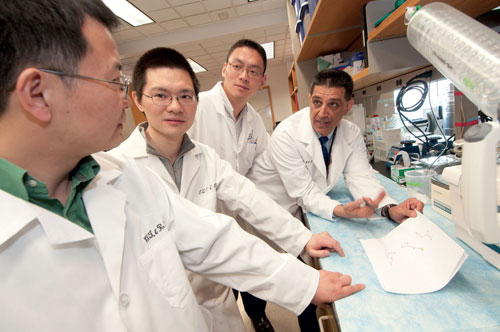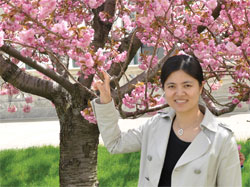Building on a decade of work detailing the power of fish oils to calm inflammation, HMS researchers have succeeded in showing that compounds synthesized by the body from these oils can also shut down pain. The compounds, called resolvins, have the potential to form a new family of analgesics. They reduced inflammation-related pain in mice without the dangerous side effects—like addiction or cardiac damage—that can come with long-term use of painkillers such as opioids and Cox-2 inhibitors.
Because so much work has already been done—patents filed, intellectual property licensed, and phase II clinical trials completed (for a treatment of dry eye)—it might seem that putting resolvins to work against pain for the patients’ sake would be easy.

Not so, said principal investigator Charles Serhan, the Simon Gelman professor of anesthesia at HMS and Brigham and Women’s Hospital, a biochemist interested in acute inflammation and its natural resolution. “The barriers to clinical development are so high, it’s unbelievable.”
Being GreenSerhan began this work in the late 1990s, when he discovered the resolvins and their role in reducing inflammation (see Focus, August 10, 2001). The finding flipped scientists’ thinking about inflammation as a chain of biological events that passively fades over time to a programmed phenomenon that actively shuts itself down. The discovery also led Serhan to approach his research with a specific question in mind: “How does the body regulate acute inflammation naturally?”
This approach contrasts with structured drug design, which typically involves identifying the cellular machinery behind a disease process, then using structural biology to design a small molecule that jams that machine. “The problem is that these inhibitors can cause extreme toxicity,” said Serhan, “and they can be very hard to steer.”
The discovery of resolvins’ role in reducing inflammation and pain exemplifies Serhan’s alternative approach. In fact, Zhen-Zhong Xu, a collaborator on the recent work, called resolvins a “green drug” because of their role as a natural protector. Since the body produces resolvins naturally, said Xu, they may cause fewer side effects in humans.

In 2005, Serhan patented resolvins, spun off a company called Resolvyx, and has since created analogs that are longer lasting and dial more specifically into target cells than the natural molecules.
In this most recent work, published online April 22 in Nature Medicine, Serhan joined with Ru-Rong Ji, a neuroscientist at the Brigham, to see if resolvins had any effect on inflammatory pain. Ji’s team, including co–first authors and research fellows Xu and Ling Zhang, found that injecting two different resolvins, E1 and D1, into the spinal cords of several mouse models reduced inflammatory pain as effectively as morphine or a COX-2 inhibitor, but at manyfold lower doses.
“The fact that resolvins are very potent is good for potential manufacturability,” said Serhan. “You don’t need to make as much.”
Unlike existing pain drugs, the resolvins did not affect normal responses to pain; the mice could still feel the pain of new injury. “With an infusion of morphine, you don’t feel pain at all,” said Ji, an HMS associate professor of anesthesia. “You no longer have the protective mechanism of normal pain perception.”
“There is a huge unmet need for better analgesics,” said Linda Porter, a National Institutes of Health program director who helped review the Transformative Research grant that funded this work. “This project is innovative in that they link the role of resolvins to cellular activity in the [mouse] spinal cord that leads to chronic pain.”
The Off SwitchJi found that resolvin E1 damps pain by acting on a receptor, called ChemR23, found on peripheral and central neurons. This is the same receptor that resolvins target on immune cells to quash inflammation, relieving the source of the pain, said Ji. By also acting on both peripheral and central neurons, the compound directly reduces pain. It also reverses the hypersensitivity that can cause pain to persist even after a wound is healed.
Just eight months before Ji and Serhan reported these findings, Resolvyx Pharmaceuticals announced positive results for the phase II clinical trial of a formulation of resolvin to treat chronic dry eye.
“It cost $43 million to complete that translational work,” said Serhan, a member of the scientific advisory board. “Now we have a new breakthrough, but this earlier work blocks the ability to start new things.” The Resolvyx team has neither the funding nor the time to think about taking on a new application that affects a different physiological system, even though they have the most comprehensive experience working with the drug in the pharmaceutical industry.
“There’s an enormous clinical potential for treating pain with resolvins that is in limbo right now,” said Serhan, who has filed, with Ji, for a new patent for these findings on pain; the intellectual property for resolvins and their use in pain has not yet been licensed by a corporate developer. “We’re always thinking that translational medicine is like a baton that we pass off to industry. But it’s not that at all. You have to push the baton.”
For more information, students may contact Charles Serhan at cnserhan@zeus.bwh.harvard.edu or Ru-Rong Ji at rrji@zeus.bwh.harvard.edu.
Conflict Disclosure: Patents on analogs of resolvins have been awarded and assigned to Brigham and Women’s Hospital, and Charles Serhan is the inventor. These patents are licensed for clinical development.
Funding Sources: The National Institutes of Health; the authors are solely responsible for the content of this work.


